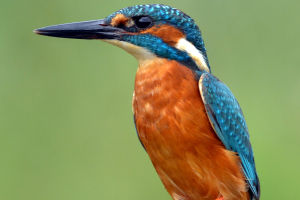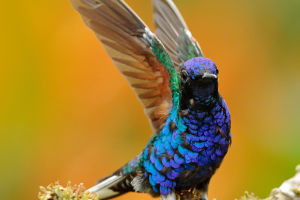Hummingbirds, also known as wood nymphs, comprise approximately 600 species within the Swifts order and hold the remarkable title of being the world's smallest known birds.
These petite creatures possess the unique ability to hover in mid-air by rapidly beating their wings, achieving an impressive frequency of 15 to 80 beats per second, depending on the hummingbird's size.
The name "hummingbird" derives from the distinctive humming sound emitted by their wing flaps.
Moreover, these birds are the sole avian species capable of flying in reverse, as well as maneuvering effortlessly in any direction.
Renowned for their vibrant plumage, hummingbirds are often classified alongside swifts within the Apodiformes order, although they can also be listed separately as Trochiliformes.
Their distribution is primarily limited to the Western Hemisphere, showcasing a diverse range of species, particularly in South America.
While around a dozen species are commonly found in the United States and Canada, only the ruby-throated hummingbird (Archilochus colubris) breeds in eastern North America, spanning from Nova Scotia to Florida.
Despite their prominence and allure, the evolutionary history of hummingbirds remains a fascinating enigma.
Due to their small size, hummingbird skeletons are unable to be preserved as fossils, leaving scientists to unravel their ancient origins.
Most hummingbird species reside in Central and South America.
Fossil records discovered in South America provide evidence of hummingbirds existing as early as one million years ago, suggesting their origins trace back to the Pleistocene epoch.
However, recent research conducted in southern Germany has revealed an even more ancient hummingbird fossil, dating back over 30 million years to the Oligocene epoch. These findings indicate that hummingbird ancestors appeared much earlier than previously assumed.
Studies estimate that the most recent common ancestor of all modern hummingbirds lived approximately 22.4 million years ago in parts of South America.
This relatively recent timeframe suggests that hummingbirds experienced rapid diversification upon their arrival in South America, leading to the multitude of species we observe today. As these avian wonders are exclusively found in the Americas, their unique adaptations and evolutionary journey continue to captivate researchers.
But how did hummingbirds make their way from Eurasia to South America, considering their high energy needs?
Researchers hypothesize that they followed the Bering land bridge from Eurasia to North America before continuing their journey southward.
Once in South America, these nectar-feeding birds settled in various habitats abundant in nectar resources, leading to rapid diversification into numerous taxonomic groups, containing hundreds of species.
Some 120,000 years ago, hummingbirds migrated back to North America and subsequently invaded the Caribbean at least five million years ago.
In these regions, new species continue to emerge at a rapid pace, emphasizing the profound impact of bioregions on speciation. Interestingly, the Andes Mountains have played a critical role in the diversification of hummingbird species, with the emergence of new species occurring at a similar rate to non-mountainous regions. These findings align with previous research highlighting the Andes' impact on biodiversity.
The genetic analysis further reveals that hummingbird diversity continues to thrive, with new species being created at a rate that surpasses extinction rates.
Hummingbirds exhibit a wide range of foraging and nesting behaviors across diverse terrestrial habitats.
They predominantly seek out nectar-producing flowers, which can be found in habitats such as arid scrub jungles, desert oases, coastal lowlands, tropical rainforests, northern boundary pine forests, and alpine tundra.
These habitats span a wide range of elevations, from heights exceeding 4,876 meters in the Andes to inland deserts below sea level.
Hummingbirds can even be spotted in urban and suburban areas where natural food sources are available, thanks to the proliferation of aviaries and gardens.
Male hummingbirds typically gather at traditional courtship grounds to exhibit their aerial acrobatics and attract female mates.
During courtship, males showcase breathtaking flying maneuvers, reaching heights of over 30 meters before diving toward the female and ascending again.
Due to their high metabolic rates and the energy expenditure involved in active flight, hummingbirds spend around 70% of their time roosting and resting. Their strong curiosity drives them to explore brightly colored objects, often mistaking them for food.
Hummingbirds are diurnal, actively foraging during the day, with peak foraging occurring at dawn and dusk.
In conclusion, hummingbirds stand as remarkable avian wonders, captivating us with their petite size and extraordinary abilities.
Their ability to hover, fly in all directions, and produce a distinct humming sound sets them apart from other bird species.
While their evolutionary history remains shrouded in mystery, recent discoveries have shed light on their ancient origins.
As guardians of nectar-filled ecosystems in Central and South America, hummingbirds continue to enchant us, reminding us of the boundless beauty and diversity found in the natural world.


